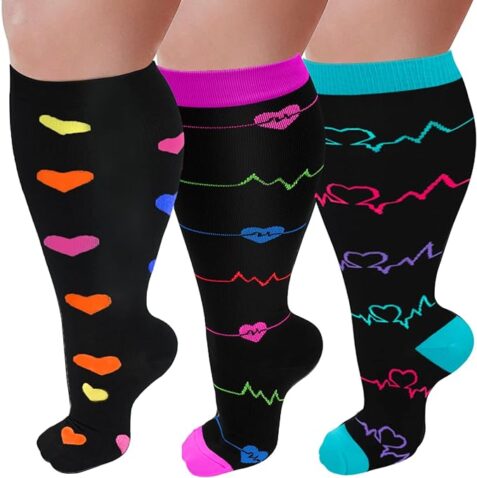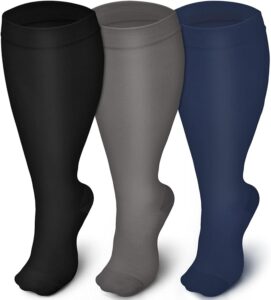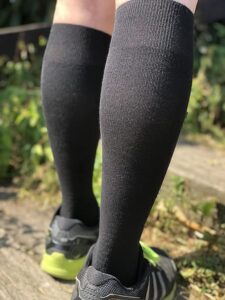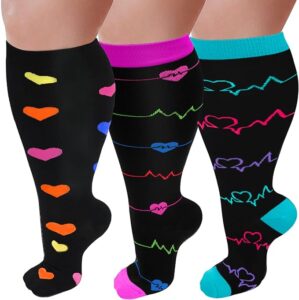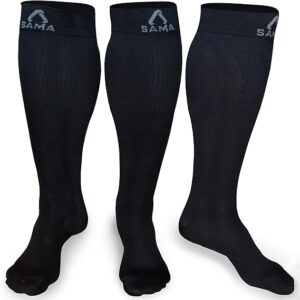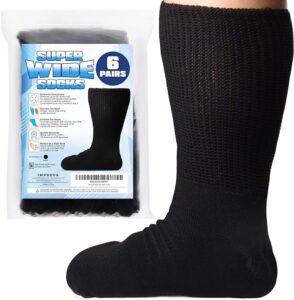Finding your correct compression socks for women in plus size is an absolute must, if you want to ensure comfort and effectiveness. Know what to look for before you buy.
This article evaluates the best compression socks for women and provides tips when considering compression socks in plus sizes including how to take measurements for size.
Tips Before You Buy Compression Socks for Women in Plus Size
The biggest mistake you can make when looking for plus size compression socks for women is to buy a pair of socks simply because it has a label which says “plus size.
This is because not all “plus size” labels are the same. You should check for features like compression level and type, size and width, material, reinforced toe and heel, and ease of putting on the socks.
While all these are important, always first check for the style and color. There is no need buying yourself a pair of socks in a style or color you do not fancy! Check a previous article – Compression Leg Socks – How to Select and Buy.
Compression Level
All compression socks (including compression socks for women) come in at least four levels of pressure, measured in millimeters of mercury (mmHg).
The appropriate compression level for you will depend on your specific needs and the recommendation of your healthcare provider.
Common compression levels include mild (8-15 mmHg), moderate (15-20 mmHg), and firm (20-30 mmHg).
Plus-size individuals may require higher compression levels to achieve the desired therapeutic effect.
Wide Calf Considerations – A Must in the Choice of Best Compression Socks for Women in Plus Sizes
Plus-size women often have larger calves, so ensure that you look for compression socks for women with wide calf options. These socks are designed with extra room in the calf area to ensure a proper fit without cutting into the skin or causing discomfort.
The Best Compression Socks for Women – Plus Sizes
It is generally difficult to find compression socks for plus sized women as separate designs. The socks are usually sold as unisex, for both women and men.
Search results will generally pull up plus size compression socks, or wide calf compression socks for women, plus size compression socks for women with extra wide calf.
Five popular brands for best compression socks for plus sized women are listed below, but read the detailed information provided in this post to help with your selection:
- AOLIKS Plus Size Compression Socks for Women and Men Wide Calf
- HOYISOX Plus Size Compression Socks for Women and Men, Wide Calf Extra Large
- GET-FA Plus Size Compression Socks for Women and Men, Wide Calf
- SAMA DILIGENCE Compression Socks for Women and Men, Wide Calf
- IMPRESA Extra Width Socks for Lymphedema – Bariatric Sock
Proper Size – How to Take Measurements
Accurate sizing is important for the effectiveness and comfort of any compression socks, including compression socks for women.
Manufacturers usually provide sizing charts that take into account calf circumference, ankle circumference, and leg length. Measure your legs as instructed to find the right size for your needs.
Measure the Calf Circumference
Move up to the widest part of the calf, typically about 15-20 cm (6-8 inches) below the knee. Wrap the measuring tape around the calf and record the measurement.
Common mistake: Pulling the measuring tape too tightly or not keeping it level, which can lead to inaccurate measurements.
Measure the Length of the Leg
To determine the length of the leg, measure from the floor (while seated with feet flat on the ground) to just below the knee crease, where you want the top of the compression sock to reach. Record the measurement.
Common mistake: Measuring too high or too low on the leg, resulting in an uncomfortable fit.
Note any Specific Needs
If you have specific medical conditions or requirements, these may affect the fit or compression level of the socks. You may need different levels of compression on different parts of the leg as recommended by a healthcare professional..
Consult the Manufacturer’s Size Chart
Different compression sock brands may have slightly different sizing charts. Use the recorded measurements to select the appropriate size based on the manufacturer’s recommendations.
Try on the Socks
Once you have purchased the compression socks based on the measurements, try them on to ensure they fit comfortably and provide the desired compression.
Other Common Mistakes to Avoid
- Measuring over thick clothing, as this can result in inaccurate measurements.
- Measuring too tightly, which can lead to discomfort and inadequate blood flow.
- Not consulting the manufacturer’s size chart or using outdated measurements you took a while back.
- Assuming that one-size-fits-all compression socks will work for everyone.
By following these steps and avoiding common mistakes, you will find the best compression socks for women for plus-size individuals that provide the required support and comfort based on specific needs and preferences.
Graduated Compression or Non Graduated Compression Socks
Ensure that the compression socks have graduated pressure, with the highest pressure at the ankle and gradually decreasing as it moves up the leg.
Graduated and non-graduated compression socks serve different purposes and offer distinct advantages.
Graduated compression is generally preferred for most individuals due to its specific benefits, especially when it comes to medical and therapeutic applications.
Here are the advantages of graduated compression over non-graduated compression in the choice of compression socks:
Advantages of Graduated Compression Socks |
|
|---|---|
| Factor | Consideration |
| Improved Blood Circulation | Graduated compression socks are tighter at the ankle and gradually loosen as they move up, aiding venous return and circulation, especially beneficial for DVT, varicose veins, and venous insufficiency. |
| Reduced Swelling | The graduated pressure minimizes fluid buildup, reducing edema in ankles and legs, beneficial for prolonged standing or sitting situations like travel or work. |
| Prevention of Blood Clots | Recommended for at-risk individuals during long flights or post-surgery, the improved circulation and pressure distribution decrease the risk of clot formation. |
| Alleviation of Leg Fatigue | Reduces tiredness in legs, ideal for those with jobs requiring prolonged standing or individuals on their feet for long periods. |
| Varicose Vein Management | Manages symptoms like pain, discomfort, and swelling, providing consistent pressure and support to affected areas. |
Advantages of Non-Graduated Compression Socks |
|
| Factor | Consideration |
| Muscle Support | Non-Graduated Compression Socks provide support during physical activities like running or weightlifting, reducing muscle vibration and fatigue, potentially enhancing performance and recovery. |
| Faster Recovery | Aids in muscle recovery post-exercise by increasing blood flow and reducing muscle soreness, commonly used by athletes and active individuals. |
| Energy and Endurance | Believed by some to enhance endurance during sports activities, although scientific evidence is mixed on this aspect. |
| Created by Metamorphosishub.com 🦋 | |
The choice between graduated and non-graduated compression socks depends on your specific needs and intended use. Graduated compression is typically recommended for medical conditions and situations requiring enhanced circulation and edema management.
Non-graduated compression, on the other hand, is more common in athletic and performance-related settings, where muscle support and recovery are the primary goals.
Always consult with a healthcare professional or specialist to determine the most appropriate type of compression sock for your individual needs especially if you have a medical condition.
Material and Comfort
The choice of material for compression socks for plus-size women can significantly impact comfort and effectiveness although the best material will depend on individual preferences and needs.
Many materials are are made from a blend of nylon and spandex, which provides stretch, durability, and comfort. Look for socks with moisture-wicking properties to keep your feet dry and comfortable throughout the day.
Some common options include:
Graduated Compression Fabric
Graduated compression socks are typically made from a blend of synthetic materials such as nylon, spandex, or elastane. These materials provide stretch and elasticity, allowing the socks to provide graduated compression, which is tighter at the ankle and gradually decreases up the leg.
Benefits: Graduated compression helps improve blood circulation by assisting the veins in pushing blood back to the heart. This can reduce swelling, fatigue, and the risk of blood clots in the legs, which is particularly important for plus-size individuals who may be at a higher risk of circulation-related issues.
Moisture-Wicking Fabrics
Compression socks often incorporate moisture-wicking materials like Coolmax or Dri-FIT technology. These fabrics help to wick sweat away from the skin, keeping the feet dry and reducing the risk of blisters and discomfort.
Benefits: Plus-size individuals may experience more perspiration due to increased weight, so moisture-wicking materials can keep the feet dry and comfortable, reducing the risk of skin irritation and odor.
Antimicrobial Materials
Some compression socks are made with antimicrobial-treated fabrics that help prevent the growth of bacteria and fungi. This is especially important for those with diabetes or other conditions that affect skin health.
Benefits: Antimicrobial properties can help maintain healthy skin and reduce the risk of infections or complications.
Cotton Blends
Cotton-blend compression socks can be a good choice for individuals who prefer natural fibers. Cotton can provide breathability and comfort.
Benefits: Cotton-blend socks are comfortable and may be suitable for those with sensitive skin. However, they may not offer the same level of compression as synthetic blends.
Latex-Free Materials
Many compression sock manufacturers offer latex-free options for individuals with latex allergies or sensitivities.
Benefits: Latex-free materials prevent skin reactions and discomfort, ensuring a comfortable wearing experience.
Ultimately, the best material for compression socks in plus-sizes for women depends on individual preferences, sensitivities, and specific medical needs. If you are unsure, consult your healthcare professional or specialist.
Also trying on different brands and styles to find the most comfortable and effective option where possible is a good approach.
Seamless Design or Reinforced Toe and Heel
Look for compression socks for women with seamless or flat-seam construction. This minimizes the risk of skin irritation and provides a smoother, more comfortable fit as it prevents rubbing and chafing against the skin, which can be particularly important for plus-size individuals.
However, note that compression socks can wear out quickly in the toe and heel areas. Therefore, choose socks with reinforced toes and heels for added durability, especially if you plan to wear them regularly.
Compression socks for women with reinforced toes and heels tend to be more expensive than their counterparts with a seamless design.
The price difference can be attributed to several factors related to the materials used and the manufacturing process. Here’s why compression socks with reinforced toes and heels are often pricier:
Why Compression Socks with Reinforced Toes and Heels are Often Pricier |
|
|---|---|
| Factor | Reason |
| Use of More Durable Materials | Thicker and more durable materials are used in reinforced areas, increasing longevity, especially beneficial for plus-sized compression socks for women. |
| Specialized Production | Additional manufacturing steps and specialized machinery are needed to reinforce toes and heels, contributing to higher production costs. |
| Longer Lifespan | Added durability results in a longer lifespan, making them a cost-effective choice for regular wearers of compression socks. |
| Targeted Support | Reinforced areas provide extra support and protection in high-stress regions, beneficial for medical or occupational needs. |
| Specific Use Cases | Designed for particular activities or conditions, such as work or sports, with additional features like moisture-wicking or cushioning, contributing to higher prices. |
| Seamless Design | More budget-friendly option for everyday wear, focusing on comfort, but may lack durability compared to reinforced socks, especially under rigorous activities. |
| Created by Metamorphosishub.com 🦋 | |
Ultimately, the choice between compression socks with reinforced toes and heels and those with a seamless design depends on your specific needs and budget.
If you require compression socks for medical reasons or for activities that put extra strain on your socks, investing in reinforced options may be worth the higher cost.
However, if you prioritize comfort and intend to wear your compression socks casually, seamless designed compression socks for women may be more cost-effective and suitable.
Style and Color of Plus Size Compression Socks for Women
You will find that the best compression socks for women in plus sizes come in more limited styles and colors. While medical-grade compression socks may have a more clinical appearance, there are also fashionable options available.
Choose a style and color that suits your personal preferences and lifestyle.
Easy to Put On
Look for socks with features like a reinforced heel pocket, toe box, and stretchy fabric that make them easier to don. Some compression socks for women can be challenging to put on, especially if they have high compression levels.
Consult a Healthcare Professional
It is advisable to consult with a healthcare professional, such as a vascular specialist or a certified fitter, to determine the appropriate compression level and fit for your specific condition and needs.
If you experience any discomfort or adverse effects, consult with a medical professional promptly.
Related Articles
- Poor Circulation Problems in Seniors – The Real Dangers
- The Best Products That Can Help Improve Poor Blood Circulation
- Compression Leg Socks – How to Select and Buy
- Compression Socks For Men or Women – Better than Unisex?
- The Causes of Poor Blood Circulation in Aging Adults
Conclusion – Best Compression Socks for Women
Properly chosen and well-fitted plus sized compression socks for women can significantly improve leg comfort and circulation for women with wide calves and anyone in need of this type of support.
Before making a purchase, always use this guide to check for relevant criteria like compression level, type of compression, size, material, reinforcements and ease of putting on the socks.
References
Compression stockings. Medline Plus. https://medlineplus.gov/ency/patientinstructions/000597.htm Accessed 10/2/23.
A Guide To The Best Compression Socks For Seniors (2023) https://www.forbes.com/health/medical-supplies/what-are-compression-socks/

